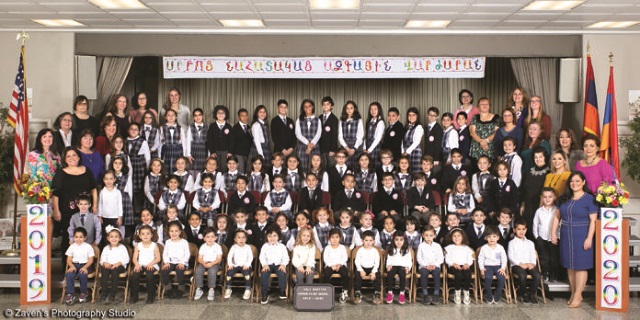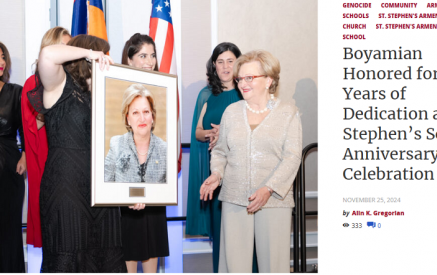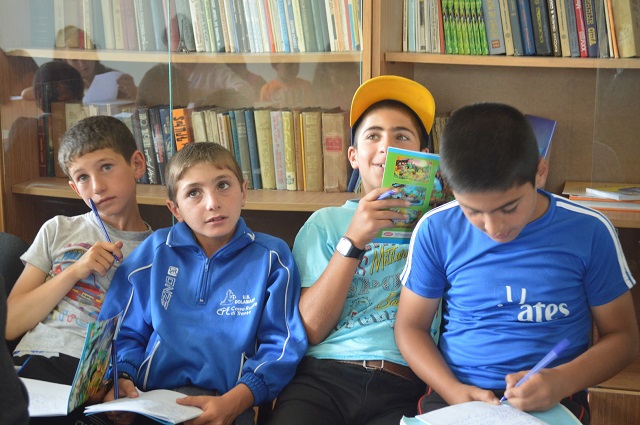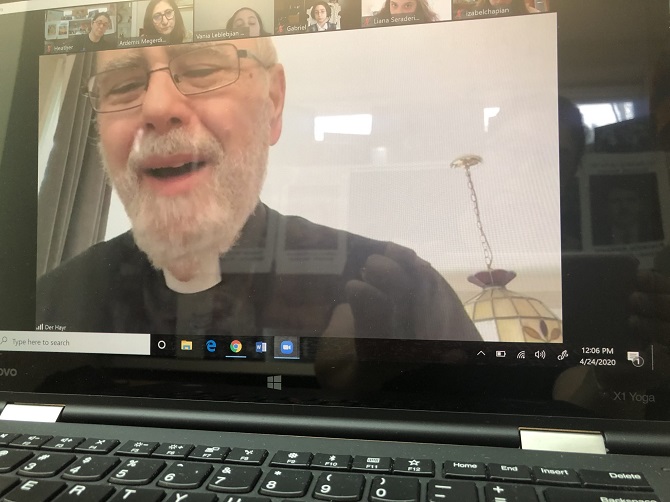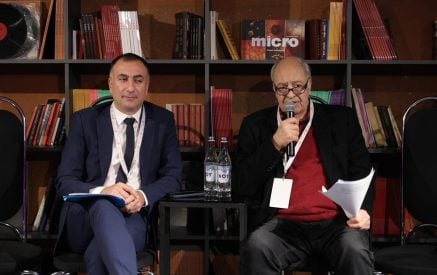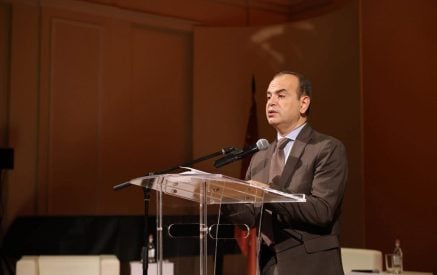The Armenian Mirror-Spectator. NEW YORK — The COVID-19 pandemic upended lives around the world, affecting public health, the economy and the education system. As the school year opens this fall across the United States, institutions are working hand-in-hand with their state governments to devise, adjust and experiment with new approaches and techniques as they face never-before-seen circumstances. Coming off of an online-only spring semester where student engagement came to a halt and family dynamics were altered when schools shut down, administrations are on track and better prepared to meet the needs of their student populations.
While the new school year unfolds, Armenian day schools across the country have adjusted to the challenging situation. Due to the diminishing infection rate numbers in the East Coast, the Armenian schools have adopted a hybrid instruction, in line with state guidelines.
Armenian Sisters Academy
Located in Radnor, Penn., a suburb of Philadelphia, the Armenian Sisters Academy is ready to launch its remote and in-person model when classes begin on September 8.
Read also
The school serves 130 students from pre-kindergarten through eighth grade and is led by Principal Sister Emma Moussayan and Vice-Principal Daniel Commale. Pennsylvania, like its neighboring states, has been able to get a handle on the virus throughout the spring and summer months. Thanks to the progress, faculty and staff look forward to welcoming students on campus for the first time in six months.
“The adjustment was pretty seamless,” said Commale of the switch to remote learning. “We had to close on a Thursday afternoon and quickly go into a digital format in order to have everything available online for parents and students by the following Monday.”
Although the remote lessons could have caused more stress to students and families, Commale noted that some students “excelled” while others still “craved that face-to-face human interaction.” A common observation amongst the faculty, however, was that students were not as jovial as they were while physically in school.
When school let out in June, the teachers continued to design new lesson plans for the fall and participate in online meetings over Zoom. By early August, many came back to school to set up their classrooms.
“Our priority has always been to prepare a safe, loving and caring environment for our students,” said Sister Moussayan. “Our teachers are prepared and they know the responsibilities expected from them.”
The Armenian Sisters Academy, which offers a bilingual curriculum in Armenian and English along with Spanish language lessons for all grades, was founded in 1967 and maintains the Montessori-based philosophy, encouraging spiritual development and cultural initiatives. This year, however, while Armenian cultural celebrations will continue to thrive in the classroom, special presentations to the ASA families will be temporarily on hold.
“Unfortunately we can’t have all of the students and parents together in the building, but we are thinking of alternatives to keep that collective cultural part alive in our school,” said Sister Moussayan.
As the school year begins, the plan is to offer in-person instruction five days a week for students, who can opt to come in everyday or spend one half of the week in-class and the other half attending their classes remotely. To elevate cleanliness standards and ease the fears of students and teachers alike, the Armenian Sisters Academy has made an extra effort to update sanitizing stations, increase ventilation systems and airflow, mandate mask-wearing in the classrooms, and hire more cleaning professionals who will be on campus all day.
Holy Martyrs Armenian Day School
When the doors to the Holy Martyrs Armenian Day School in Bayside, Queens, open on September 9, Principal Seta Megherian, alongside her staff, are ready to receive their students with open arms.
“We have missed the children and they, too, want to make that connection,” said Megherian, who noted that students used Zoom throughout the spring semester, where the children received an enriching experience in English and Armenian. “The school is doing everything to ensure a safe return for the kids, families and teachers.”
Holy Martyrs Armenian Day School, which was established in 1967 initially as the Hye Bardez Nursery School, currently has 90 students and emphasizes an Armenian language and cultural education, while focusing on legacy. Megherian credits the small-school setting as a reason why they were able to successfully transition to an online model over the last few months.
“Our wonderful parents saw what our school provided when the pandemic hit and they appreciated that there was no waiting period and no unknown,” said Megherian, herself an alumna of Holy Martyrs Armenian Day School. “The teachers taught on Zoom and classes resumed as normal as normal can be.”
Maintaining a positive and upbeat virtual environment was a priority for Megherian and her faculty, who observed that students were surpassing their curriculum content and moving onto higher levels of reading and science.
“We have been working very tirelessly with our Board and our teachers to welcome our students back into their family home space,” said Megherian. “We want to ensure the safety of our students and make sure everything is ready to go.”
Board Member Natalie Gabrelian, who is an alumna of Holy Martyrs Armenian Day School, acknowledged that there was “no disruption” to the students’ learning thanks to the “dedicated teachers who went above and beyond with their creativity to bring classrooms to life.”
“These unprecedented times have brought to light so many of our daily heroes, and we owe immense gratitude to our educators and school leaders who have been fighting at the frontlines of education since March, when they were called into action to make a quick transition to remote learning,” said Gabrelian, who serves as Director of Education at AGBU.
She appreciated the efforts of Megherian and Secretary Maro Jamgotchian, who together with the committed Parent Teacher Organization made sure that the students and families stayed connected with entertaining events, including virtual trips, scavenger hunts, family Bingo night, graduation and the “verchin zank” last bell celebration on the final day of school.
“In its vast history, the unprecedented experiences of the last few months will definitely stand out in our history books,” said Gabrelian. “As we approach the start of a new school year, we are forever grateful for our dedicated administration and faculty and our community of staunch supporters. Together we can ensure the next chapters tell the story of a much brighter future.”
Hovnanian Armenian School
Across the river in New Milford, NJ, the Hovnanian Armenian Day School has also adopted a 100% in-person model, according to Acting Head of School Chris Sarafian, who set up technology for remote instruction inside the classroom for any students who choose to continue learning from home.
“While we’re encouraging everyone to come back to campus, we won’t turn away a family who wants to leave their child at home for the term,” said Sarafian. “We believe it’s better for students to learn in person, particularly for the social and emotional aspects, and we have had open communication about this with our parents.”
Coming off a “challenging spring semester” where teachers had to “reconfigure their way of teaching with no notice,” Sarafian is optimistic for the fall term. While he acknowledges that there may be anxiety for some who are returning to campus, there is also enthusiasm for physical interaction.
“Our teachers have been creating and recreating, adopting and adapting to the new environment, as are the students,” said Sarafian. “Some students did very well online and were more productive and focused, whereas others did not do as well with the online component.”
During the months of remote learning when the pandemic forced a lockdown, Sarafian started a volunteer class called “Kicking it with Mr. Chris” to keep students engaged when he heard from a parent that their child was unhappy and hadn’t smiled in a long while.
“Hearing that bothered me,” said Sarafian. “Even though it was by definition a senseless class, the students loved it because they laughed and it was like a once-a-week vent session.”
When students return to school, there will be an in-person counselor to talk to them about their concerns. A wellness class is also on the schedule so students can discuss the impact the pandemic has had on them and their families.
Developed in conjunction with the Hovnanian School Alumni Association, the R.E.A.C.H. Initiative (Readiness for Education, Activities, Care, and Health) will help raise funds for the upcoming school year in terms of acquiring and installing equipment, technology and supplies to ensure a safe and secure opening for the upcoming school year.
“This year there was an increased request for financial aid,” said Sarafian. “Through this initiative, we can award more scholarships and financial aid to encourage families to send their children to Hovnanian School.”
R.E.A.C.H. aims to also offset the increased expenses as a consequence of COVID-19 that were not budgeted into the school year, such as bulk purchases of hand sanitizers, masks, gloves, disinfectants, PPE equipment, added cleaning staff and a Clorox 360 Electrostatic Sprayer, among many other items.
The school, founded in 1976, currently has an enrollment of 135 students from 8 weeks old through the eighth grade.
The school will also set up tents and sun shades outside to accommodate outdoor classes and an outdoor dining area, weather permitting. The classrooms will be rotation-based and the school will encourage students to be outdoors as much as possible, where the risk of the virus is much less likely to spread.
Looking towards the 2020-2021 school year, Sarafian sees it as a community effort.
“Everyone will have to buy-in this year and that includes staff, parents, teachers and students,” he said. “We all have additional responsibilities this year to protect our children and our staff. It’s important everybody works together to achieve that goal to keep everyone safe.”
St. Stephen’s Armenian Elementary School
St. Stephen’s Armenian Elementary School in Watertown, Mass., organized a special advisory Task Force to devise a reopening plan for the preschool, kindergarten and elementary school students.
“We are working hard to prepare for the academic year, ensuring health and safety issues, without sacrificing the quality of education,” said Principal Houry Boyamian. “We are in the midst of a pandemic while trying to maximize the educational experience for our students.”
The administration and the school’s Education Committee and Health Committee have been following all educational, health and state guidelines when the fall term opens on September 14. St. Stephen’s will offer two operations for its elementary students, including a mix of two days on campus and three days remote, or one hundred percent remote. Faculty and staff will continue to assess the status and progress of students in both the hybrid plan and remote-only plan, as well as monitor the state of the pandemic throughout the school year.
“Our detailed planning and preparation will allow us to shift our elementary program to either one hundred percent in-person instruction or one hundred percent remote learning when COVID-19 guidelines and circumstances change during the academic year,” said Boyamian.
The approach for the preschool and kindergarten students will be different, since they are housed in the newly constructed and spacious Afeyan Building, with plenty of room for social distancing. Students in kindergarten will receive four days of in-person instruction and one day of remote learning, whereas the preschool students will have a one hundred percent in-person program, while complying with the Department of Early Education and Care (EEC) guidelines and implementing advanced cleaning protocols, according to Boyamian.
Maintaining open communication and academic school year plans with parents has been a priority for Boyamian and her administration. They have shared details about the education, health and safety plans with parents to give them the full scope of the upcoming months in order to help them decide what learning model they want to choose for their children. Parents were also encouraged to participate in online Zoom meetings and submit questions to the school’s administration.
“St. Stephen’s Armenian Elementary School continues to provide an excellent bilingual education to our students, who are eager to return to school after three months of remote learning,” said Boyamian of the bilingual school that was founded in 1985 and promotes the Armenian language and culture in an intimate school community and environment. “I’m very thankful to our teachers for their resiliency, flexibility and cooperation, and their ability to come back and resume teaching in person.”
AGBU Alex & Marie Manoogian School
In the Midwest, the AGBU Alex & Marie Manoogian School evaluated whether they should re-open with a hybrid model or remain remote when they start classes on Tuesday, September 8. While the large classroom spaces were conducive to social distancing and the administration drew a 32-point plan for hybrid teaching under Principal Hosep Torossian’s tutelage, the Board ultimately decided to open the school with distance learning for the month of September and assess month by month.
“Our decision is common to most Michigan schools with the same dilemma,” said Torossian. “We understand face to face teaching is better than online teaching and the students crave being in school together with their teachers, but the Board will continue to evaluate its position.”
He cited concerns with the quantity of materials presented online, which were particularly challenging for the elementary school students who found it difficult to sit in front of the computer for up to six hours a day. The bilingual curriculum that fosters the Armenian language, mathematics, science, history, language arts and the encouragement of developing a strong cultural and individual identity, has been easier for the high school students to adjust to remotely.
Despite the pandemic’s impact on educational institutions and learning, there has not been a decrease in enrollment at the kindergarten through twelfth grade school, named after benefactors Alex and Marie Manoogian when it was established in 1969.
“There is a tremendous bond within our Manoogian School community and we have extremely dedicated parents and teachers,” said Torossian. “They are one hundred percent behind our decision.”
That longtime confidence was further instilled last March when Michigan Governor Gretchen Whitmer shut down all of the schools to combat the coronavirus in the state – and the Manoogian School was one of the few that “turned on a dime.”
“Within days of the announcement all of our teachers began teaching online and we were fortunate we never lost a day of schooling,” said Torossian. “The teachers did an outstanding job switching immediately from face-to-face instruction to online, to the great satisfaction of the parents, students, administration and the Board.”
Each student coped differently during the months of online learning and the teachers stayed on top of who was motivated and who needed an extra push. One math teacher in particular sent and received 34,000 screenshots within the three months of online learning, according to Torossian, highlighting the level of devotion of the teachers to ensure their students understood the materials presented virtually.
Special counseling was offered to students as well, including ESL teachers and teachers working with special needs students to “minimize the impact on students who needed help the most.”
“We have never experienced anything like this, but given the circumstances, kudos to the Manoogian teachers for giving two hundred percent during these dire circumstances,” said Torossian, who acknowledged that some of the families within the school were impacted by COVID-19 and the school paid special attention and engaged counselors to lend a hand. The administration also offered technology for anyone who needed a computer, hardware or internet access and will continue to do so in the upcoming school year.
As of now, scheduling remote learning remains a priority for Torossian and his faculty to make sure that homes with multiple children who attend the Manoogian School are all able to have the appropriate time with their computers and resources during the distance learning period.
“We have to be careful with how we schedule so all siblings have equal access to technology at home,” said Torossian. “We are working to create equitable access to all.”
Glendale Unified School District
The surge of COVID-19 on the West Coast, particularly in California, has caused Governor Gavin Newsom to issue a county watchlist, resulting in the majority of schools to teach fully online in the fall. In Los Angeles there has been a recent boom in cases, causing the school systems, such as the Glendale Unified School District, which serves 26,000 students — a heavy proportion of whom are Armenian — to kick off their school year virtually on Wednesday, August 19.
Glendale Unified School District Board of Education at-large member Nayiri Nahabedian was on site at the Columbus Elementary School on the first day of school when parents and students visited the campus to pick up textbooks and all related stationary for the school year, from notebooks to pencils.
“It’s important that all of us be positive and enthusiastic and energetic about the school year,” said Nahabedian, who was first elected to the Board in 2007. “There is no question that these are challenging times, but we need to work together and be patient with one another and ourselves in order to have the best possible learning experience for our students.”
While the numbers have been improving over the last couple of weeks, Nahabedian said the Board of Education will remain “committed” to following the safety protocols of Los Angeles County and the State of California as long as they remain on the watchlist.
“We will see how we can, as safely as possible under the circumstances, bring our students back to the classroom in the future,” she said.
Nahabedian acknowledges remote learning relies heavily on family circumstances and children in vulnerable families are “at risk of learning loss.”
“Public education is supposed to be the great equalizer and bring kids together of all backgrounds to have equal opportunity,” said Nahabedian, who noticed that during the pandemic some families have had the means to create learning pods while other children haven’t had that same privilege. “There are parents who are capable of sitting with their child and working with them throughout the day on their schoolwork, while other parents don’t have that same capacity or the luxury of working from home, causing those kids to lose out.”
Moving forward, the potential plan is to move into a hybrid model later in the fall. State, health and education officials will monitor the caseloads, new infections per capita, test positivity rate and hospitalization rates — but until conditions improve and counties are off the list for at least two weeks — they will continue to teach online.
The Glendale Unified School District, which serves preschool through twelfth grade in over 30 schools in the region, has earned the National Blue Ribbon honor, the U.S. Department of Office of Education’s highest designation. It’s also one of the area’s largest employers, with more than 3,000 teachers, administrators, and support staff.
Throughout the months of remote instruction last spring, Nahabedian observed that many students thrived on structure and being present in the classroom with a live teacher giving instructions. The district bridged the gap, technology and equipment-wise, by providing a Chromebook to every student who requested one and hotspots for Internet access.
“Our challenge is having the students work with the equipment and understanding that the equipment is the bottom minimal standard and we need to think beyond that,” said Nahabedian.
If the public health situation does change and students are permitted to receive in-person instruction in the classroom, GUSD will remain committed to maintaining and accommodating a remote option if parents are not ready to send their children back into classrooms.
In the meantime, for the families who are essential workers or have special circumstances and must send their children to school this fall, GUSD created technology pods for elementary school students, an initiative that Nahabedian said is “unique and forward-thinking.”
“Technology pods give students the opportunity to be back in their elementary classroom with their Chromebook, while following all safety protocols, and do distance learning from inside the school,” said Nahabedian, who noted that more than 1,000 elementary-aged students are taking advantage of this option.
“Our teachers are teaching from their classroom as well because they have found that the classroom is a safe and a more convenient way for them to conduct distance learning,” said Nahabedian, emphasizing that all teachers follow safety protocols and the Board has ensured they have a clean space to work in.
“It’s challenging for our employees, our parents and our students,” said Nahabedian. “But it is the moral responsibility of the adults right now to show up for the children and to care for them and to teach them.”
Taleen Babayan
Caption: Holy Martyrs Armenian Day School photo for the 2019-2020 academic year.



















































